Books
What we are reading and re-reading
BOOK REVIEW
Monsoon Economy – The Price of Conquering Nature
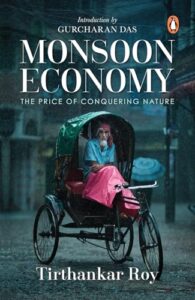
This book, well-researched and combining robust arguments with anecdotal references, traces the contemporary history of what monsoons have meant to the Indian economy and how water security – or water scarcity – have informed and influenced not only the economy but also the society, the polity and resistance movements focused on water. A series of interventions by the government and non-government organisations from the late 19th century addressed the famine and water access facilitating agricultural growth, increasing urbanisation, and better health parameters for many. But Roy argues, and rightly so, that these came at a cost to India’s environmental sustainability.
The book, in which Roy frequently refers to ‘water famine’ and ‘water stress’, explores and details out India’s economic life through the prism of water as it is available, exploited, commercialised, fought for. The seasonality of a monsoon economy is brought out well, so is the high cost of India’s “success” in managing its water resources in a monsoon-fed economy. The book weaves together economics and environmental concerns, rejects many cliches associated with both, and asks questions about what sustainability means in the South Asian (and Indian) context, what the cost of interventions making water-dependent economic development would be, what all of this would mean in the era of climate change, and difficult ones like whether making water more accessible to many has increased the stress on it as a resource.
Roy does not shy away from charting out the picture of water as a precious resource as he sees it in a country or region that is highly dependent on the monsoon even after all these decades. A professor of economic history at the London School of Economics and Political Science, Roy’s book forms an invaluable addition to the understanding of multi-dimensional subjects of water-monsoon-economic development-sustainability. It is a must-read.
- Title: Monsoon Economy
- Authors: Tirthankar Roy
- Publisher: Penguin Business
- Year published: 2023
- Pages: 224
- Price: Rs 499
BOOK REVISIT
Chasing The Monsoon: A Modern Pilgrimage Through India
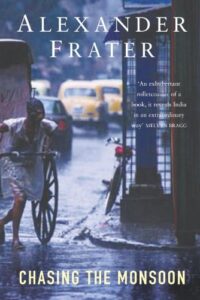
British travel writer and journalist Alexander Frater was called a “wise, witty companion for whom the journey was the key” by the redoubtable The Guardian when he passed away in 2020. His epochal book on India’s monsoon was then 30 years old and a classic in a complex genre of writing on India. When it was first published, Chasing the monsoon was unlike any travel writing in the sub-continent with standard anecdotal experiences, awe-inspiring heritage monuments, and passing references to filth and poverty. Frater was on a different path – travelling from Kerala towards the north and northeast of India, sometimes behind or at times with the southwest monsoon.
In his telling, Frater charts his own non-tourist route dictated by the monsoon’s path, lives off the uncertainty, manages his aches and pains, interacts with local people everywhere – a yellow-black taxi dropped him mid-way in heavy rain in Bombay but slum dwellers took him – chronicles his experiences of a place and its people from the monsoon lens. He leaves us with a picture in words about how the monsoon sweeps across India – sometimes gently, often cruelly. Frater writes about the land, the punishing summer sun, water shortages, pelting rain, flooded cities and all but not without the people and how they predict the monsoon in places, how they celebrate the rain, how in Rajasthan’s Deeg they attempt artificial rain, and how the pilot landing in Meghalaya’s Cherrapunji – then with the highest rainfall – had the cunning to beat the ominous clouds but the locals gave him a hostile reception.
Frater’s narrative still has power; the book does not seem dated and is worth going back to. While travel writers, many of them Indian, have written about offbeat places and experiences since then, no one has matched Frater’s scope and scale of the monsoon over India. For Frater, this was a geographical pilgrimage and a tryst with all that prevails even now – bureaucratic delays and lapses, unresponsive governments, warm and hostile people, missed connections in travel. This is Frater’s self-discovery as a person, beyond a travel writer; we watch him and the gigantic canvas he paints with words of the Indian monsoon.
- Title: Chasing The Monsoon: A Modern Pilgrimage Through India
- Authors: Alexander Frater
- Publisher: Picador
- Year published: 1990
- Pages: 288
- Price: Rs 650
BOOK READ
Shades of Blue: Connecting the Drops in India’s Cities
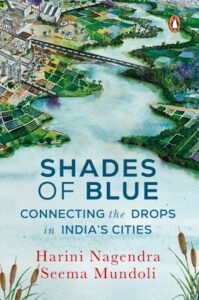
Ecologists and professors Harini Nagendra and Seema Mundoli’s book on water in our cities follows the format that their popular book on trees did: merging and weaving in personal anecdotes, historical references, studies and ground situation to make a lively but thought-provoking read. The writers follow the water trail, exploring how our cities flourished on fertile lands along rivers, lakes, seas and oceans, and, in every case, draw attention to the state of these water bodies here and now as they lie exploited and neglected. Through comprehensive research that they make accessible, they draw out the relationship of water and water bodies with cities – and then bring a sense of urgency to the grave ecological concerns about water.
The book takes the reader on a journey across the various ‘shades of blue’ – from the Yamuna in Delhi to the Cauvery in Karnataka and the Pichola Lake in Udaipur to the Brahmaputra in Assam – stringing together a powerful narrative on growth of cities along water bodies and its subsequent, often damaging, effects on the natural water systems. We meet interesting characters and find tiny stories about the water bodies. The book is sprinkled with anthropological, legal and scientific accounts, also pulling in various anecdotes, myths and folktales. Nagendra and Mundoli make strong points and arguments but always with a deft touch. They show how water, despite being the very source of life, is our most endangered resource in cities.
In a conversation with Question of Cities on the aftermath of urban floods, Nagendra advocated for a “co-created system, which brings together civil society, corporates, academia, political representatives and governments is necessary”. She also stresses that what cities need now is “planning for the extreme climate scenarios”. This book follows the duo’s earlier co-authored work titled Cities and Canopies, both vivid accounts of what cities in nature could be. This book is highly recommended for both the curious lay reader drawn to books on cities as well as professionals in the fields of urban planning and sustainability.
- Title: Shades of Blue: Connecting the Drops in India’s Cities
- Authors: Harini Nagendra, Seema Mundoli
- Publisher: Penguin Random House India
- Year published: 2023
- Pages: 286
- Price: Rs 499
BOOK READ
Cities and Canopies: Trees in Indian Cities
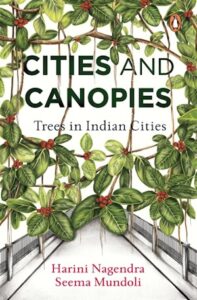
In this older book, ecologists and professors Harini Nagendra and Seema Mundoli, take readers on a nostalgia-led journey of trees with delightful stories of these “gentle life-giving creatures”. From individual trees such as the banyan and jamun to the need for tree cover in cities and the role they play in climate change mitigation, the authors do not let the narrative sag. Whether native to the land or imported, worshipped or not, of culinary importance and otherwise, mind-boggling floral varieties, trees have helped shape identities and are witnesses to our rapidly transforming cities, they write.
In a languid way, without resorting to the usual academic prose but always anchored in data and reports, Nagendra and Mundoli show how, over decades, trees are not just agents that reduce the impact of climate change but also historical creatures and ‘nature’s own museums’. Trees exist silently in the background of city life, giving shade, space to rest, play, read and just be, offering relief on a hot day. A tree’s absence can be felt more strongly than its presence, albeit only after it vanishes to make space for new concrete structures.
As more trees are hacked and urban forests cleared, by policy, to make way for new construction, this book is worth going back to as a reminder that cities need trees to hold and shape urban lives. Nagendra, in an interview to Question of Cities on the importance of trees, said, “…the value of a city is as a place of commerce, not as a place of well-being. The part that gets the most traction, in the media or residents’ associations or the government, is the impact of trees on pollution because it’s related to public health.” This book rekindles the urge to know trees, call them your own and take responsibility for them. As climate events like heat waves and floods become more frequent and intense, ravaging cities, the importance of trees as the foundation for climate resilience cannot be overstated. This book is a must-read.
- Title: Cities and Canopies: Trees in Indian Cities
- Authors: Harini Nagendra, Seema Mundoli
- Publisher: Penguin Random House India
- Year published: 2019
- Pages: 256
- Price: Rs 499
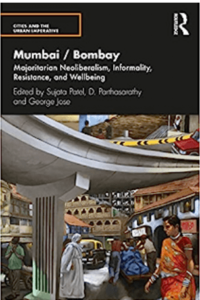
In about a thousand pages, this volume — fourth in the series examining Mumbai / Bombay — attempts to explore complex themes such as neoliberalism and majoritarianism through the events and developments of the last three decades. In doing so, it raises a number of questions about the manner in which the city developed, the impulses and decisions which powered its urbanisation, and the different ways in which Hindu majoritarianism and neoliberal capitalist accumulation reorganised the city through its tumultuous recent past. Scholars and writers drawn from a range of fields and the editors — Sujata Patel, D Parathasarthy, and George Jose — weigh in on work and labour, heath and education, spatial planning, infrastructural development, politics and identity in their chapters and show how deliberate decisions to turn the city into a financial centre, deregulate multiple aspects, and give primacy to land deregulation transformed its very character by impacting the informal economy and society. It is, as political scientist and author Christophe Jaffrelot writes in the blurb, “a true analytical atlas of the city from below”.
It is paradoxical, the editors write in the introduction, that “while encouraging urbanisation as a solution for the ills affecting the new nation, the Indian state and its stakeholders had very little understanding of what interventions are needed to have a successful urbanisation programme” and adopted the western thought that industrialisation would herald in urbanisation. A major argument in the volume is that (Hindu) majoritarianism affected the way in which neoliberal programmes were designed and implemented in the city which was an attractive site for these processes given its pre-eminent position in a numbers of fields, and then across chapters examines the impact of this majoritarianism-neoliberalism on individuals, corporates, social groups, minorities, and women who benefited and did not benefit from the resulting rent-seeking and populist programmes. Chapters on land, planning (difference between how Powai was planned compared to the far suburbs of Vasai-Virar), gendered peripheralisation of work and workplaces, Hindutva and meat businesses, health and healthcare, neoliberalism and Islamic-English schools, among others, bring out the recent past of Mumbai / Bombay.
The worth of this volume is that it is an approachable academic gaze at the lived experiences of millions in the city, placing the events and processes of the last few decades seen on the ground — growth of informality in many sectors, hardening of land as the city’s only currency, movement of lower-middle classes from the city to suburbs, growing antipathy towards groups fuelled by the Shiv Sena and more — within the large and complex contexts of neoliberalism and majoritarianism. It is a challenging task but the editors have nearly pulled it off. They write that they had to leave several papers out of the volume. It is tempting to imagine the layers of complexity and perspective that those would have brought too. Even so, this volume is a worthy addition to the series which analyses Mumbai/Bombay as no other.
- Title: Mumbai / Bombay - Majoritarian Neoliberalism, Informality, Resistance, and Wellbeing
- Authors: Edited by Sujata Patel, D. Parthasarathy, and George Jose
- Publisher: Routledge
- Year published: 2023
- Pages: 257
- Price: Rs 995
BOOK REVIEW
The Indian Metropolis: Deconstructing India's Urban Spaces
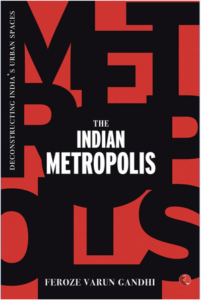
As an intellectual piece of work, this thick volume by parliamentarian Feroze Varun Gandhi, of the ruling Bharatiya Janata Party, ranks well above that of his peers in its scope, breadth, and depth. Gandhi’s choice of subject is interesting to the extent that politicians do not usually engage this deeply with urbanisation and city-making, preferring instead to launch or inaugurate micro projects here and there. In that sense, Gandhi’s engagement itself is a departure from the norm. The books displays this in good measure. It has hundreds of references and citations in each of the ten chapters, drawing heavily from published material on India’s cities and urbanisation journey over the years. It brings a sense of history to the table, burrowing into ancient India’s cities and city-making. It then lays out in great depth and detail the situation that today’s cities find themselves in across sectors such as healthcare, water, transport, crime, local finance and so on. And it is prescriptive with Gandhi suggesting and recommending the way forward in each sector that he devotes a chapter to.
Gandhi’s work is heavily lifted by the on-ground stories that he weaves into the larger scope of every sector, people’s stories from across India which show how broken our cities are, including Tier II and III cities where the process of urbanisation meanders uncomfortably with established traditions and conventions. These stories humanise the points Gandhi makes in his writing, illustrate why urbanisation must not leave anyone behind in any way. For his focus, for the vast scope and the admirable depth he brings to this work, Gandhi must be commended even though large parts of his writing is not unfamiliar to liberal planners and urbanists. However, urbanisation or city-making is hardly devoid of the macro political-economic forces at play, cities are home to and driven by capital, even global capital. This aspect of urbanisation rarely makes its presence felt in the book. Even if some of Gandhi’s ways forward in any sector have to be adopted, his friends and rivals in the political arena will have to come on board. What Gandhi has done with this volume is to bring a vast set of resources, data sets, voices and a few ideas on India’s urbanisation in one place. It’s a good place to begin debates — if he can get his peers involved.
- Title: The Indian Metropolis: Deconstructing India's Urban Spaces
- Author: Feroze Varun Gandhi
- Publisher: Rupa Publications
- Year published: 2023
- Pages: 824
- Price: Rs 1,500
BOOK REVISIT
Locking Down the Poor: The Pandemic and India’s Moral Centre
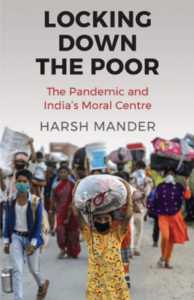
When the pandemic hit the cities in 2020 and most people scurried for cover locked inside their homes, millions hit the streets to return to their homes back in villages. This book is a compendium of their stories which have since fallen off the media map. Harsh Mander, the former bureaucrat and now a social activist of reckoning, brings to the volume his understanding of the system which locks out the poor, his experience of working with the disadvantaged, his quiet sensitivity and humanism to record the hardships that millions faced during the pandemic and the lockdown.
Originally published in 2021, Mander gives us a glimpse of the dread and the panic that started to unravel just a few hours after the March 2020 lockdown was announced. There are personal accounts of the unemployed daily wage earners, migrant and informal workers, their frights and concerns with hunger and homelessness during that time. “A young woman with a listless baby at her hip speaks into the camera held by my young colleagues who are interviewing people affected by the lockdown. She addresses Prime Minister Modi and Chief Minister Kejriwal. ‘Is this the state you want to reduce us to?’ she asks them piercingly. Another woman says, ‘We fear we are fated to die. They say this Corona illness will go on for a year. They will later say we died of Corona, but actually would have died of hunger.’”
The stories in the volume take off the veil that the pandemic was managed well and shows us the travesties that followed a poorly planned lockdown and its compounding impact on migrants and other marginalised while making a case against it. Mander does not hold back on expressing his thoughts about how policies were structured and what role the Indian government played during the crisis. This is a must-have-on-the-shelf book for it makes us question our moralities and rethink our understanding of privilege in the face of adversity at this scale – a humanitarian crisis.
- Title: Locking Down the Poor: The Pandemic and India’s Moral Centre
- Author: Harsh Mander
- Publisher: Speaking Tiger
- Year published: 2021
- Pages: 233
- Price: Rs 260
BOOK REVISIT
Chandigarh: In Search of an Identity

First published in 1987, Chandigarh: In Search of an Identity charts the rise of Chandigarh as one of India’s new cities built after independence. In it, Kalia explores the merging of the political and urban planning efforts to create on a clean slate an entirely new city in 1949 to serve as the seat of government for Punjab which had lost its capital, Lahore, to Pakistan in the Partition. He delves into the story of the city’s planning and development through the key personalities including the then Prime Minister Jawaharlal Nehru and architect Charles Edouard Jeanneret – more popularly known as Le Corbusier – to trace how the city, especially its Capitol Complex, came to be. Kalia devotes space also to the husband-wife architect team of Edwin Maxwell Fry and Jane Beverly Drew who designed housing, among other aspects in the new city, but whose work is less discussed in popular literature.
Kalia explores the history of this city in relation to the politics that have shaped it. He delves into the ambitions of its politicians and planners while also talking about the ideals that Nehru and Le Corbusier wanted to follow. When it was planned and built, it carried the hopes of a new nation modernising itself and the city was seen as the architectural expression of the Modernist narrative. However, the plan emphasised the built environment more than the people, their social and economic relations, and their interaction with the city. To paraphrase, Kalia notes that though hopes ran high for the new city and its symbolism in the newly-independent India, the emphasis was far too great on designing buildings and roads network while discounting ways of life, sociological and community aspects of urban life. Chandigarh finally “…turned out to be a designed city, not a planned one.”
- Title: Chandigarh: In Search of an Identity
- Author: Ravi Kalia
- Publisher: Southern Illinois University Press
- Year published: 1987
- Pages: 320
- Price: Rs 11,696
BOOK REVISIT
Feminist City: Claiming Space in a Man-Made World
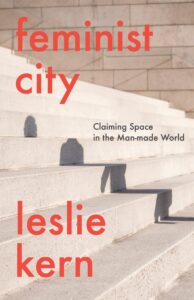
Cities, as centres of exclusion and inequalities, can be alienating and oppressive for the marginalised especially for “female bodies, female needs, female desires,” as Kern frames it and, in five chapters, brings to light what it means to be a woman in a city. “Women still experience the city through a set of barriers – physical, social, economic, and symbolic – that shape their daily lives in ways that are deeply (although not only) gendered,” she writes, weaving together her personal experiences and popular culture in the context of urban scholarship. Her lens remains steadfastly feminist throughout the book.
Kern takes personal questions – why doesn’t my stroller fit on the streetcar, why do I have to walk an extra half mile home because the shortcut is too dangerous, who will pick up my kid from camp if I get arrested at a G20 protest – and applies the classic intersectional analysis to paint a picture of the modern city, any city, as highly inadequate for women because their structures keep women “in their place”. She takes the reader through cities from the perspective of women, pointing out the inequalities that go unnoticed right under our nose, focuses on the different ways in which people experience cities, and how cities deepen the Right to the City and right to protest – or not.
The book has an abundance of the personal but there are adequate intersectional and academic references which allow significant lessons to be drawn from her experiences. Importantly, the book throws light on the sense of solidarity and empowerment among people when they collect on the streets, on how women realise their Right to the City when they watch others occupy the space that is rightfully theirs, on the role of protests that shape generations of women, on gentrification and segregation. “Nothing that we have wasn’t fought for; nothing that we’ll gain in the future will be given without a fight,” she writes at one point.
The book is an easy read raising difficult questions about cities and the place of women in them. Feminist City is an essential addition to the shelves of urban planners, architecture college libraries, women’s groups, rights’ organisations and others with more than a passing interest in feminism and everything urban.
- Title: Feminist City: Claiming Space in a Man-Made World
- Author: Leslie Kern
- Publisher: Verso Books
- Year published: 2020
- Pages: 224
- Price: Rs 1,742
BOOK REVISIT
One hundred years One hundred voices

This volume is more than what it describes itself as. “The mill workers of Girangaon: An oral history” is how the intriguing title is described, but this book stretches well beyond the treasure that it is for history lovers and chroniclers. It’s a unique warp and weft of the city of Mumbai, lakhs of its working classes, the trajectories of their personal lives with that of the cotton textile mills which once defined Bombay, the culture and cuisine that it spawned, the music and literature and memories that they carried well after the textile mills area – Girangaon because girni is mill in Marathi – had been superimposed by the neo-liberal commercial spaces with their glass-façade towers replacing the tall chimneys of the mills, and more.
The textile mills’ strike involving 2.5 lakh workers was well-documented, the space of nearly 600 acres occupied by the mills in land parcels in the heart of the city had received attention from planners and architects, the political and commercial aspects of the fateful decision to allow redevelopment of the “surplus” land in the mill precincts was debated and protested too, but what went through the minds and lives of mill workers and their families through it all remained a blank area. Meena Menon and Neera Adarkar, with their astute observations flowing from their work as activist and planner respectively, and intimate knowledge of both Girangaon and its residents, fill in the blank in ways that record the voices of mill workers for posterity.
Little details that can only come from years of familiarity with the area and their grounded perspective of social justice make this book a treasure. The opening essay by Dr Rajnarayan Chandavarkar, Cambridge-based historian and political scientist, elevates both the intellectual fibre and intrinsic value of the work of Menon and Adarkar. The gallery of rare photographs gives visual depth to the oral histories. This volume is for keeps – and to return to again and again for anyone interested in Mumbai’s central area and the voices on its streets.
- Title: One hundred years One hundred voices
- Authors: Meena Menon and Neera Adarkar
- Publisher: Seagull Books
- Year published: 2004
- Pages: 430
- Price: Rs 695
BOOK REVISIT
Varieties of Environmentalism - Essays North and South
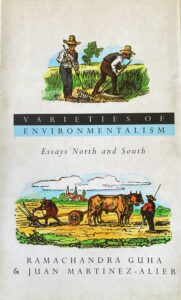
“The centrality of nature to (Patrick) Geddes’ theory of town planning is evident in the one general treatise he wrote on the subject, as well as in several dozen town plans he wrote on assignment in India between 1915 and 1919, all of which reveal a subtle understanding of the ecological processes in the formation, functioning, rise and decline of cities…At a more philosophical level, Geddes was an early harbinger of that ‘general revolution in science now in rapid progress, the change from a mechanocentric view and treatment of nature and her processes to a more and more fully biocentric one'” goes a section of the book devoted to environmental movements across the global North and South. Here, Geddes, appears as a cameo — a happy coincidence for Question of Cities in an edition devoted to the polymath — but that is only one of the reasons to return to a book that is nearly 25 years old.
The reference to Geddes, biologist and town planner among other hats he wore, came in the context of the work of Lewis Mumford and others who worked at the intersection of urbanisation or urban form and ecology. The focus of the book was on environmental movements, conflicts, ideological anchors, and key players. When it was published, Ramachandra Guha and Juan Martinez-Alier had managed to significantly alter the conversations on environmentalism in the poorer countries of the South given that the emphasis in discussing environmental movements was on the countries of the North. In the immediate years after the Rio Earth Summit in 1992, there was an awakening of sorts in the world that studies about environmental movements till then were heavily biased in favour of the developed countries of the North while the world’s poorer nations, it was believed, were “too poor to be green”. Yet, countries across Asia and Latin America had a bewildering variety of environmental movements rooted in their soil and culture, whose expressions were different from those of the movements in the wealthier North.
The authors parsed these movements, discussed the orientation of the environmentalism of the poor, and explored the conflicting priorities and approaches between the movements of North and South which had come to the fore during the Rio Summit. They bring us descriptions and analyses of movements, personalities, and projects across North America and Europe contrasted with those in Asia and Latin America, and do not shy away from registering the conflicts. The chapters on the environmentalism of the poor, poverty and environment, and cross-cultural environmental ethic firmly placed the book on the shelves of environmentalists in America and Europe. With this one, Guha, whose writing on ecology was to be later over-shadowed by that on history, and Martinez-Alier, then an economist at the University of Barcelona, fulfilled the key purpose of writing books: Opened minds and influenced opinions. Nearly 25 years later, it remains a relevant, even a necessary, book to pick up.
- Title: Varieties of Environmentalism - Essays North and South
- Authors: Ramachandra Guha & Juan Martinez-Alier
- Publisher: Oxford University Press
- Year published: 1998
- Pages: 230
- Price: Rs 395 (now Rs 3,198 online)
BOOK READ
Metronama: Scenes from the Delhi Metro
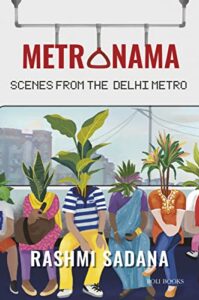
When a piece of shiny new infrastructure such as the metro network is introduced into a large city, it does not merely provide transport options to people but interacts with the urban fabric, even changing it in many ways. The metro in Delhi does not – did not – mean the same thing to all people. It liberated some, especially women who did not own or could not afford a car and did not want to use the city’s dreaded bus services; for the poorer inhabitants of the city, it meant a level of exclusion in a ubiquitous aspect of their city, the clean stations at odds with their bastis nearby and the gleaming air-conditioned coaches at great variance with dirty and stinky buses. This book captures it all – and more.
There are detailed descriptions of various processes and places such as the Metro Bhavan which oversees the transport network, there are voices and more voices, including that of women who found the metro liberating in their lives, there are insights into the impact of the metro on Delhi’s urbanisation, and there are visuals brought on paper such as the reference to children excited by their reflections in the metro windows. Sadana, an anthropologist, brings the finer aspects of the field into her observations and inferences when she explores themes such as how well – or not – the metro has integrated into Delhi’s rhythms, what the metro network means in terms of public space in the city, the spatial struggle that the metro is now part of as veteran activist Dunu Roy tells her, and so on.
Without making heavy weather about urban sociology, Sadana brings several layers of it to attention vis-à-vis the metro in Delhi. Between the pages of this deceptively simple-looking book, there are references to the symbolism of the designs used, the complicated tendering process through the words of an architect who was involved, women’s compartments against the general ones, and voices of several people to whom the metro has come to mean something. Through it all, what becomes a steady hum in the background is Sadana’s exploration of the core question of who does the metro really serve and, therefore, how does it impact the city as a whole. There are parts that the author could have delved deeper into, but it is an important addition to the non-fiction literature on cities.
- Title: Metronama: Scenes from the Delhi Metro
- Author: Rashmi Sadana
- Publisher: Roli Books
- Year published: 2022
- Pages: 297
- Price: Rs 495
BOOK READ
The City Makers: How Women are Building a Sustainable Future for Urban India
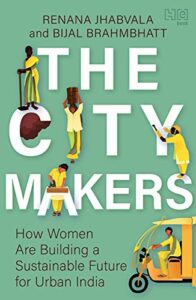
Between lofty words such as women’s empowerment and its demonstration in terms of transformation in women’s lives, there lies a great deal of granular and painstaking work. Scores of non-governmental organisations – mainly women’s organisations – have silently done this work for decades but few have chronicled it, fewer have been studied or evaluated. This is an important gap in documentation. ‘The City Makers: How Women are Building a Sustainable Future for Urban India’ seeks to fill the gap with intimate knowledge of the processes and pains that went into positively impacting lives of nearly 1.7 million women, as it claims, across India through the Ahmedabad-based Mahila Housing SEWA Trust (MHT).
The MHT, an initiative of the iconic Self Employed Women’s Association (SEWA) whose work of mobilising marginalised women into cooperatives has won international acclaim, has been focused on marshalling urban poor women to access permanent houses and basic amenities since its inception in 1994. The book documents this in great depth and fine details, bringing alive the role of some of the women through their stories and achievements. There are tales of struggle, success, and solidarity among the women as they negotiate the difficult terrain of policy and paperwork – handheld by the MHT – to build and own houses, negotiate with government and private sector officials, make meaningful contributions to urban planning, include concepts of sustainability, and so on. The book documents MHT’s work across India, including in tribal areas, and spans from training women and drawing on collective strength to helping them articulate demands and develop tangible projects on ground. Every chapter provides lessons.
Written by Renana Jhabvala, recognised for her stellar work in organising women in the informal sector and her long association with SEWA, and Bijal Brahmbhatt, who has headed MHT for decades, the book benefits from their intimate knowledge of the work and familiarity with the processes that the organisation has followed, which an independent chronicler may have missed out on. However, intimacy becomes a hurdle when it comes to dispassionate evaluation of the work, the processes or its philosophy of partnerships with corporates. The critique, if and when done, will have to lean heavily on the documentation in this book; even if it does not come to pass, the book is an important addition to our knowledge of how women’s empowerment is made a reality.
- Title: The City Makers: How Women are Building a Sustainable Future for Urban India
- Authors: Renana Jhabvala and Bijal Brahmbhatt
- Publisher: Hachette India
- Year published: 2020
- Pages: 208
- Price: Rs 399
BOOK REVISIT
Triumph of the City: How Our Greatest Invention Makes Us Richer, Smarter, Greener, Healthier and Happier

When “Triumph of the City…” was published a decade ago, there were poor jokes about its unwieldy title. Edward Glaeser, professor of economics at Harvard University and its author, seemed to not mind. A strong voice propagating the magic of free markets on cities, Glaeser brought his ideology to bear on how the city economy brought out the best in people who were richer, smarter, healthier and happier than those in suburbs or nearby rural areas. Using reportage and analysis, and writing in a conversational tone, Glaeser was upbeat about economic advantages of cities, their multiplier aspect, and benefits of urban life; he was challenging or overwriting the notion of cities as unsustainable, dirty, poor and crime-ridden.
Glaeser’s free-market perspective in lauding the modern city – a construction of the capitalist enterprise itself – sat uneasy with those who swore by Jane Jacobs ‘school’ of urban design and planning; his approach to environmental aspects and equity issues in cities was tested in the last decade – not favourably. However, the book offered a racy read on the successes and failures of urbanism taking the reader into a number of cities in the US and the world. Glaeser described how New York had healthier people, some industrial cities thrived but others like Detroit crumbled, how temperatures in January determined house prices, how environmentalists on the West Coast of the US had harmed the environment, and so on.
Indian cities featured too as Glaeser travelled to Bengaluru, then Bangalore, and compared it to the Silicon Valley to place the cities – and city-making – in the technology boom in India and the US. Kolkata was in the book too but not in a flattering way. Glaeser peppered his narrative with history (Baghdad as intellectual mecca), economics (throughout the book), and prescriptions (what can be done to discourage urban sprawl and suburbanisation). Parts of the book read well a decade later, others sound redundant or overtaken by economic cycles and ecological crises such as Climate Change and extreme weather events. But it’s worth a read for both the serious student of urbanism and the party-chatter who wants to sound knowledgeable about cities.
- Title: Triumph of the City: How Our Greatest Invention Makes Us Richer, Smarter, Greener, Healthier and Happier
- Author: Edward L. Glaeser
- Publisher: Penguin Books
- Year published: 2012
- Pages: 352
- Price: Rs 709 for online buy
BOOK READ
Outcaste Bombay – City Making and the Politics of the Poor
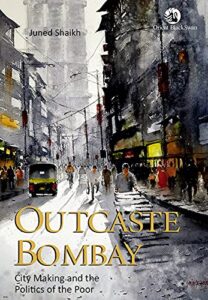 This is a story of Bombay, or Mumbai, as it’s rarely narrated or heard. In the hands of Juned Shaikh, former journalist and presently history professor at University of California, Santa Cruz, the city reveals layers that are hidden in plain sight. Shaikh narrates the story of the city at the intersection of industrial capitalism, class and Marxism, city planning and housing with his thoughtfully selected tools of the records and minutiae merged with language, literature and poetry to show how caste is ever-present – and determines so much about life – in a supposedly cosmopolitan city.
This is a story of Bombay, or Mumbai, as it’s rarely narrated or heard. In the hands of Juned Shaikh, former journalist and presently history professor at University of California, Santa Cruz, the city reveals layers that are hidden in plain sight. Shaikh narrates the story of the city at the intersection of industrial capitalism, class and Marxism, city planning and housing with his thoughtfully selected tools of the records and minutiae merged with language, literature and poetry to show how caste is ever-present – and determines so much about life – in a supposedly cosmopolitan city.
There are town planning reports and historical documents of the colonial era in the book, then there’s Marathi by Dalit writers and poets, references to jalsa and loknatya, weaving in of Baburao Bagul and Namdeo Dhasal, going into slums and sex workers’ areas among others to demonstrate the power of caste in commercial and industrial relations, in work opportunities and lack of them, in housing and use of space, and therefore in the making of the city itself. “By 1972, Bombay City had experienced three transitions. The first was horizontal spatial change, from Bombay to Greater Bombay, which accelerated the process of suburbanisation…The second was in the modalities of planning, from city planning to regional planning including the proposed creation of Bombay’s doppelganger, New Bombay…The third was the attitude towards slums of city, regional and national governments…Dalit literature thrived in the context of the production of urban space…most Dalit writers grew up in spaces designated as slums and they depicted it in their writing”.
Shaikh examines caste in the city but never lets the lens of industrial capitalism, which shaped colonial and modern Bombay, to fall off. From how merchants secured finance for their factories from their caste networks to how workers were incentivised to migrate through their caste webs and how housing in slums mostly followed caste or community lines, Shaikh is brutal in his analysis that the urban did not annihilate caste. “Capitalism has the propensity to take what it finds or leech on existing social relationships that help it accumulate more wealth,” he writes and expands on how it subtly played with caste which “was seminal to the production of urban space”. This interdisciplinary book richly adds to the writing on the city. If there’s a bone to pick, it’s that the book ends too soon; bringing in more voices, especially of women, might have given us more to engage with.
- Title: Outcaste Bombay – City Making and the Politics of the Poor
- Author: Juned Shaikh
- Publisher: Orient Blackswan
- Year published: 2021
- Pages: 227
- Price: Rs 995
BOOK READ
Colossus: The Anatomy of Delhi
 There are books on cities and then there are rich tapestries of urban life between covers. Colossus: The Anatomy of Delhi is the latter. It is unlike any book on the national capital and surrounding region in that it brings together a complex set of realities of urbanisation across three broad themes – social change, community and state, structural and social inequalities – each one informed by rigorous research and capturing the social science in the seemingly mundane aspects of life in Delhi-NCR. It’s a treasure also because it approaches the city and social science research bearing in mind that it is a uniquely Indian city that bears little to no comparison with international cities where these themes have been deeply studied. In this, it lays down a new framework in how to slice through urbanisation in India and how to study a complex and thriving city.
There are books on cities and then there are rich tapestries of urban life between covers. Colossus: The Anatomy of Delhi is the latter. It is unlike any book on the national capital and surrounding region in that it brings together a complex set of realities of urbanisation across three broad themes – social change, community and state, structural and social inequalities – each one informed by rigorous research and capturing the social science in the seemingly mundane aspects of life in Delhi-NCR. It’s a treasure also because it approaches the city and social science research bearing in mind that it is a uniquely Indian city that bears little to no comparison with international cities where these themes have been deeply studied. In this, it lays down a new framework in how to slice through urbanisation in India and how to study a complex and thriving city.
Twenty authors cover geography, demography, housing, services, migration, energy, pollution, crime, marriage, religion, caste, class, politics and politicians, spatial and social inequality with data analysis, depth writing and conceptual frameworks across 14 chapters. Edited by Sanjoy Chakravorty, professor of geography and urban studies and director of global studies at Temple University, and Neelanjan Sircar, political scientist and Senior Fellow at the Centre for Policy Research, Colossus: The Anatomy of Delhi is the outcome of focused research at the Center for the Advanced Study of India, CASI, at the University of Pennsylvania.
The book, published last year, is a must-read for anyone with more than a passing interest in cities in India, the process of urbanisation, and people who make cities into the multifaceted – often contradictory – pulsating places they are.
- Title : Colossus: The Anatomy of Delhi
- Author : Prof Sanjoy Chakravorty and Prof Neelanjan Sircar
- Publisher: Cambridge University Press
- Pages: 460
- Price: Rs 995
BOOK REVISIT
The Great Derangement: Climate Change and the Unthinkable
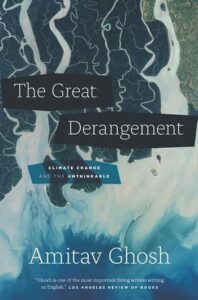 “When that monster cyclone comes towards Chennai or Mumbai, what are you going to say to it? ‘No, you’re coming for the wrong person. You should go and attack the US’.” These lines and similar others became part of conversations on Climate Change six years ago when author Amitav Ghosh unveiled his non-fiction work The Great Derangement: Climate Change and the Unthinkable. Ghosh, master story-teller who has woven ecology into his fiction earlier, addresses the urgency of the Climate Change in this volume which deserves to be re-read as the world tethers on the brink of the crisis as never before. In it, Ghosh reminds us that Climate Change “is the mysterious work of our own hands returning to haunt us in unthinkable shapes and forms”.
“When that monster cyclone comes towards Chennai or Mumbai, what are you going to say to it? ‘No, you’re coming for the wrong person. You should go and attack the US’.” These lines and similar others became part of conversations on Climate Change six years ago when author Amitav Ghosh unveiled his non-fiction work The Great Derangement: Climate Change and the Unthinkable. Ghosh, master story-teller who has woven ecology into his fiction earlier, addresses the urgency of the Climate Change in this volume which deserves to be re-read as the world tethers on the brink of the crisis as never before. In it, Ghosh reminds us that Climate Change “is the mysterious work of our own hands returning to haunt us in unthinkable shapes and forms”.
A fine illustration of literature addressing a vital ecological-life issue of our era, the book eschewed the predictable approach of facts and data to use stories and questions based on research. It makes for important reading again because Ghosh, instead of focusing on the purely literary, dives into the complex terrain of globalisation, capitalist expansion, corporatisation, and politics in tracing Climate Change. For change to happen, contemporary culture can start by questioning the conventional framework of development, and fostering collective reflection and responsibility. These have become more crucial with every passing year since the book was published. Read the IPCC reports for science, then re-read The Great Derangement for science with literary lyricism.
- Title : The Great Derangement : Climate Change and the Unthinkable
- Author : Amitav Ghosh
- Publisher : Penguin Books Limited
- Pages : 284
- Price : Rs 232
